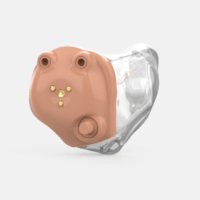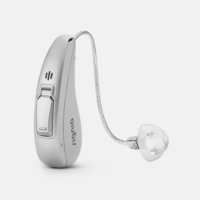Are you about to choose your first hearing aid? Or thinking to switch to a different type to better suit your lifestyle? Clients are often overwhelmed by the different types of hearing aids available in the market today. So we’ve put together this comparison to explain how each differs from one another, including their pros and cons. Learn more about each type of hearing aid:
- Completely in the Canal (CIC)
- In the Canal (ITC)
- In the Ear (ITE)
- Behind the Ear (BTE)
- Receiver in the Ear (RITE)
- Open Fit
| Completely-in-the-canal (CIC) | In-the-canal (ITC) | In-the-ear (ITE) | Behind-the-ear (BTE) | Receiver-in-the-ear (RITE) | Open Fit | |
|---|---|---|---|---|---|---|
 |
 |
|||||
| Small and discreet | ✓ | ✓ | – | – | – | – |
| Direct Volume Control | – | ✓ | ✓ | ✓ | ✓ | ✓ |
| Long Battery Life | – | – | ✓ | ✓ | ✓ | – |
| Rechargeable | – | – | ✓ | ✓ | ✓ | – |
| For Severe Hearing Loss | – | – | ✓ | ✓ | ✓ | – |
| For Profound Hearing Loss | – | – | – | ✓ | – | – |
Completely in the Canal (CIC) Hearing Aids
Completely-in-the-canal (CIC) hearing aids are designed with a mold to fit directly inside your ear canal. This gives it the unique ability to be completely discreet, and virtually invisible. For adults with mild to moderate hearing loss, CIC hearing aids are a popular choice.
| Pros | Cons |
|---|---|
|
|
In the Canal (ITC) Hearing Aids
In-the-canal (ITC) hearing aids are custom molded to fit partially in the ear canal. This type is suitable for adults experiencing mild to moderate hearing loss.
| Pros | Cons |
|---|---|
|
|
In the Ear (ITE) Hearing Aids
In-the-ear (ITE) hearing aids are custom designs offered in two types: Full Shell (fills most of the bowl-shaped area of the outer ear) and Half Shell (fills only the lower part of the outer ear). ITE hearing aids are recommended for adults with mild to severe hearing loss.
| Pros | Cons |
|---|---|
|
|
Behind the Ear Hearing Aids
Behind-the-ear (BTE) hearing aids are designed to hook over the top of the ear and rest behind it. A tube then connects it to the earmold receiver that fits into the ear canal. This type of hearing aid is appropriate for people of all ages and with any type of hearing loss, from mild to profound.
| Pros | Cons |
|---|---|
|
|
Receiver in the Ear (RITE) Hearing Aids
Receiver-in-the-ear (RITE) styles of hearing aids are similar in design to BTE types. Instead of tubing connecting the piece behind the ear to the earmold, it is a tiny wire. They are appropriate for people of all ages experiencing any type of hearing loss, from mild to severe.
| Pros | Cons |
|---|---|
|
|
Open Fit Hearing Aids
Open-fit hearing aids are also designed to hook over the top of the ear and rest behind it, with a thin wire connected to the receiver. However, the key difference is they use an open dome to leave the ear canal almost completely open.This allows for low-frequency sounds to enter the ear naturally and for high-frequency sounds to be amplified through the hearing aid. This type of hearing aid is a good choice for people with better low-frequency hearing and mild to moderate high-frequency hearing loss.
| Pros | Cons |
|---|---|
|
|
Still Need Help Finding the Best Hearing Aid?
Understand all of the different types of hearing aids but still need help finding the best one for your lifestyle? With over 20 years of experience helping clients across Toronto, GTA, and the Golden Horseshoe area, we’re here to help. In fact, we guarantee that we can help you attain the best hearing possible. Contact us today!
